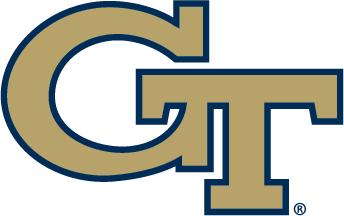Oct. 19, 2017
Andy Demetra | Inside the Chart
KeShun Freeman is a captain, a four-year starter, an AFCA Good Works Team member and generally considered a model student-athlete at Georgia Tech. But the senior from LaGrange, Ga., still has plenty of big kid in him.
Case in point: Freeman, who turns 22 next month, likes to break into spontaneous games of tag with his teammates. The slaps – and subsequent chases — can come at any moment, in almost any place.
“The whole team goes against me. I’ll tag one person and other people will see it and try to jump in. It’s an everyday thing,” the defensive end said.
It also serves as an apt metaphor for what Freeman and the Yellow Jackets try to do each Saturday to opposing offenses: tag someone and run off.
Georgia Tech’s one-minute defense may be receiving the bulk of the headlines this week, but it shouldn’t overshadow a remarkable turnaround being authored by the Jackets on third down. Entering Saturday’s Homecoming contest against Wake Forest (7:30 p.m. ET, Georgia Tech IMG Sports Network), Georgia Tech has climbed to second in the country in third-down conversion defense (22.4 percent).
Compare that to last year, when getting off the field felt like a Sisyphean task and the Yellow Jackets finished 126th — third-worst — in the country.
| Third-Down Defense | ||
| Year | Pct. | NCAA Rank |
| 2016 | 49.2 | 126th |
| 2007 | 22.4 | 2nd |
“I didn’t even know how high we were ranked. We’re just playing the game, having fun,” said defensive end Anree Saint-Amour. “It’s a great feeling. You like to put up the fist [to signal fourth down], let them know we’re off the field and to get the punt return out there,” added nickel back Lawrence Austin, whose 23 tackles lead the team.
Speaking to them this week, the Yellow Jackets pinpointed several reasons for the turnaround. Saint-Amour gave the most popular theory: that Tech has improved its play on first and second down, resulting in longer conversions for opponents. Head coach Paul Johnson echoed that thought on his weekly call-in show.
“Coach harped on this a lot of times. It was the first two downs. It would be more third-and-3’s or third-and-1’s and stuff like that last year. As far as this year, it’s been more third-and-10’s, third-and-6’s,” Saint-Amour said.
Yet here’s something interesting: the average distance for opponents on third down this year is 6.65 yards. Last year it was 6.38 yards — a difference, yes, but not as sizable as some might suspect.
| Average Third-Down Distance | |
| Year | Avg. |
| 2016 | 6.38 yds. |
| 2017 | 6.65 yds. |
So if it’s not necessarily that, then why have the Yellow Jackets improved so dramatically? Austin points to the Yellow Jackets’ experience, noting that “last year we had a lot of first-time starters.” Tech returned eight starters on defense in 2017.
Freeman cites an improved pass rush, saying the line worked hard this offseason to polish its technique.
“Last year, we were an `almost there’ type of defensive line,” he said. “This year, people have been getting back there. We’ve been closing the pocket, making it harder for the quarterback to see where he’s throwing.”
That turnaround is reflected in Tech’s “Havoc Rate,” a statistic coined by the website FootballOutsiders.com. Havoc Rate is defined as a team’s total tackles for loss, passes defended and forced fumbles divided by total plays. Last year, Georgia Tech’s Havoc Rate for its defensive line ranked 71st nationally (4.4 percent). This year, it ranks 26th (7.0 percent).
Austin likes to take partial credit for that; he says his needling of former roommate Antonio Simmons has finally paid off.
“I say, `Man, you’re not good, I can rush the passer better than you,’ just to get him a little hot and to see him come off the ball a little faster,” Austin joked. The defensive end from Jacksonville, Fla., has responded with a team-high 4.5 sacks and 5.5 tackles for loss.
But beyond a more favorable third-down distance, experience or a recharged pass rush, Georgia Tech’s players chalk up their improvement to something less tangible. Call it a shared sense of accountability between the front seven and defensive backfield.
Freeman explained.
“[Cornerbacks] Coach [Joe] Speed has this thing, we call it `the contract.’ He says, `If you get [the quarterback] to double-pump … y’all do your part, we’ll do our part.’ We’re playing for them, and they’re playing for us. That gives us a little more pride,” he said.
Austin agreed.
“If we hold them for more than two seconds, I think they’re going to get a sack. They’ve been doing a great job so far,” he added.
As a statistic, third-down defense has its blind spots – namely, it doesn’t account for teams that don’t reach third down. On its game-winning, 15-play drive, for example, Miami only faced third down once. The Yellow Jackets also know that more efficient third-down offenses await them. Wake Forest’s numbers might look modest (36 percent, 90th in NCAA), but three of Tech’s remaining opponents rank in the top 25 nationally in third-down conversion percentage.
Regardless, climbing from 126th to second in any statistical category in the span of a year is an accomplishment.
So as Georgia Tech looks to regroup on Saturday, root for the chain gang to flip to “3.” Good things have often happened.









